Owney ‘the killer’ Madden – Irish bootlegger who became the hotelier for the mob.
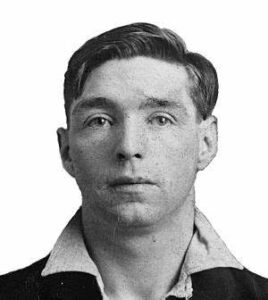
By John Joe McGinley
Owen Vincent Madden, who would later be known as Owney ‘The Killer’ Madden, was either the deadly enemy or close friend of anyone who was anyone in the 1920s and 30s New York criminal underworld.
Despite his nickname, he would not meet an untimely death, which was the usual fate of his many friends and enemies, but instead die in wealthy retirement at the age of 74 in his own bed.
Born into poverty and hardship
Owen Madden was born on the December 18, 1891, in Somerset Street, Leeds. He was the second child of Irish immigrants, Francis and Mary Madden. His father was from County Mayo and his mother from Sligo. He had an older brother Martin and would later have a younger sister Mary.
Madden was born into an Irish family in Leeds, but emigrated to New York at a young age.
Due to the industrial revolution Leeds drew many Irish men and women from the 1820s onwards. Such was the influx of emigrants from the west of Ireland that parts of Leeds became known as little Mayo. (1)
His father Francis Madden was an abusive drunk and habitual criminal who, in between prison spells, worked in the textile mills of Wigan and Liverpool. It was during one of these prison spells in 1901 that Mary Madden decided to escape her abusive husband and emigrate to America, taking her infant daughter to live with her widowed sister in Manhattan.
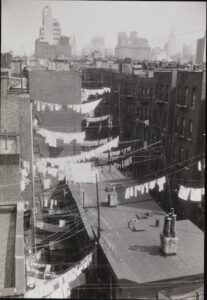
Mary reluctantly left her two boys, Martin and Owen, in a children’s home in Leeds for a year, while she worked to pay their passage to America, possibly looking for an escape from abuse and her sister in America gave her that outlet.
On June 4, 1902, Madden, together with his brother Martin sailed from Liverpool as steerage passengers on board the SS Teutonic. He re-joined his mother and sister in New York’s Hell’s Kitchen, yet another immigrant in the city’s long established Irish community. (2)
Francis Madden would never see his family again and died in March 1932.
Hell’s Kitchen had a reputation for poverty and crime which was endemic given its proximity to the Hudson River docks, where the first German and Irish immigrants found work and eventually formed gangs in the 19th century.
Geographically Hell’s Kitchen was an area in Mid-Manhattan, running from 34th street to 57th Street, west of Eighth Avenue running down to the Hudson River.
The first settlers, mostly Irish and free African Americans, lived in a network of shambolic and filthy shanty towns, where crime, sex and violence were an everyday occurrence and for many, an occupation.
With gangs such as the Hell’s Kitchen Gang, The Gorillas, The Parlour Mob, and The Gophers, the neighbourhood soon became known for its violence.
The Gopher Years
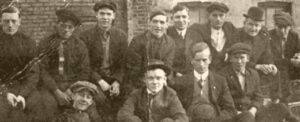
Owen Madden was never one for a schoolbook and aged just 12 he joined the Irish criminal gang that ruled Hell’s Kitchen, The Gophers.
The Gopher Gang evolved from various local street gangs in the 1890s, into what later became a committee which met semi-regularly at their headquarters known as Battle Row, a saloon owned by a minor criminal called ‘Mallet Murphy’. They met there to plan future criminal activity, sort out feuds and divide profits from their various criminal activities which included robbery, prostitution and numerous gambling dens.
Owen Madden joined the Irish criminal gang The Gophers in New York’s Hell’s Kitchen at the age of just 12.
At their peak The Gophers had as many as 500 members. They also had younger apprentice gang members, imaginatively called the ‘Baby Gophers’. These young men would eventually evolve into vicious gang members ready to take their place in The Gophers’ ranks.
Their power was so strong that they also had client gangs who would pay tribute to them, such as The Parlour Boys, The Gorillas and The Rhodes Gang.
Feared by their fellow Irish who had to pay them tribute, they were protected by the corrupt New York Tammany Hall Democratic party organisation.
As a Gopher, Owen Madden later claimed to have carried out his first major crime at the age of 14 when he robbed $500 from a man he had badly beaten.
Madden rapidly rose through the ranks of The Gophers and was a fierce fighter. He was renowned for his skill with a lead pipe and guns during tussles with rival gangs.
By the age of 18 Madden had killed five men and he soon rose to become leader of The Gophers gang. A graphic description of Madden comes from Craig Thompson and Allen Raymond in their classic, Gang Rule in New York:
“Owney was not a big boy, nor a big man either, and he did not go in for much activity with his fists. He preferred an ‘equalizer’, or pistol, a weapon that would make all men his own size. In common with his mates, he wore the turtle-necked sweater and cap which was the standard raiment for a tough guy… He talked out of the corner of his mouth in the ‘dese, dose and dem’ dialect, a habit he never got over. The thing that marked Owney for leadership in the mobs was his utter contempt for life, his own or anyone else’s.” (3)
Owney Madden was not unique in his poor and difficult upbringing, but what set him apart was his intelligence and desire for wealth. This he attained using the tools at his disposal a quick temper, strong fists and a Smith & Wesson revolver, which he wasn’t afraid to use.
Owen quickly gained his lifelong nickname of ‘the killer’ when he murdered a rival Italian gang member to celebrate becoming the leader of the Gophers. Such was Madden’s bravado that as his victim lay dying, he shouted to bystanders:
“I’m Owney Madden, 10th Avenue.” (4)
Given the vicious and violent reputation of the Gophers, it was no surprise no witnesses ever came forward, so Madden was never charged with the crime.
The Gophers’ main income came from protection rackets, where local businesses avoided firebombs by paying protection money. This was highly lucrative and funded an opulent lifestyle for the Gophers members.
Madden’s exceptional propensity for ruthless violence saw him rise rapidly in the criminal world.
In Madden’s Gopher gang, Eddie Egan, Bill Tammany, and Chick Hyland became his chief henchman. None, however, would distinguish themselves. Tammany was soon sent away for 15 years in Sing Sing prison a maximum-security correctional facility in Ossining, New York State. Hyland soon followed with a four-year term, and Egan simply dropped out of sight.
Madden was also intensely jealous of any man who showed attention to his numerous girlfriends. In 1911 he shot and killed William Henshaw, a shop clerk, whose only crime was he had asked out one of Owen’s girlfriends. Madden confronted him, shot him in a fit of jealous rage and left him for dead in the street. However, before Henshaw died, he managed to inform the police who had shot him and Madden was arrested, but all charges had to be dropped as, yet again, no witnesses would come forward.
Later in 1911, Madden married Dorothy Rodgers and fathered a daughter Margaret, his only known child. The marriage quickly ended in divorce.
Now the undisputed leader of the Gophers, Madden began to expand his territory coming into regular conflict with a rival gang, the ‘Hudson Dusters’ who wished to challenge the Gophers’ position and take over their rackets. Madden seemed unassailable as the leader of the Gopher gang, but his over-confidence would soon be his downfall.
On November 6, 1914, the Hudson Dusters struck back, their assassins ambushing Madden inside the Arbor Dance Hall on 52nd Street near Seventh Avenue.
Madden, his bravado fuelled by drink, walked into the dancehall alone and proceeded to strut like a peacock into the middle of the dance hall. A drunken Madden stood waiting for the music to stop. As he was a well- known criminal figure, men and women apprehensively left the dancefloor and sensing trouble made for the exits.
Witnesses claim Madden shouted: “I won’t bump anybody off tonight. I don’t want to spoil youse guys’ party.” (5)
Laughing at the commotion he had caused, Madden left the dancefloor and sat by the balcony drinking whiskey and people watching. He soon attracted female admirers and as he sat entertaining them, he was confronted by 11 members of the rival Hudson Dusters gang, who had only one thing in mind — to kill Owney Madden.
Perhaps it was the drink or the notorious Madden arrogance that drove him, but Owney did not run. Instead, he rose to his feet and taunted his would-be assassins: “Come on youse guys!” he hollered. “Youse wouldn’t shoot nobody! Who did youse ever bump off?” (6)
Madden and the Dusters drew their weapons and in the ongoing gunfight, Owney was hit six times. Miraculously Madden survived and when he was questioned later by the police as he recovered in hospital, he refused to tell the authorities who shot him. When asked he replied: “It’s nobody’s business but mine who put the slugs in me. The Boys will get them.” (7)
Sure, enough within days, three of his would-be assassins from the Duster Gang were dead.
While Madden recuperated from his wounds, the leader of the Dusters, William Moore, better known as ‘Little Patsy Doyle ’, made his move to usurp the Gophers and establish himself as the criminal overlord of Hell’s Kitchen. He spread a rumour that Madden’s wounds would mean his criminal career was over and that he would soon leave New York.
Doyle’s hatred of Madden was not confined to a desire to end his power; there was a more human element to it. He was intensely jealous of the fact that Madden had stolen his girlfriend, Freda Horner. When Madden left hospital, it was clear that he had no intention of leaving New York or giving up control of Hell’s Kitchen.
A war now raged between the Gophers and Doyle’s Hudson Dusters.
Justice finally catches up with Owney
As the body count in the gang war rose, Madden met with members of the Dusters and provided evidence that Doyle was in fact a police informant. This ensured he lost all support from his gang and a peace was brokered on the condition that Doyle was to be eliminated.
Madden planned his murder in partnership with Gopher lieutenants, Johnny McArdle and Art Biedler.
Women were Doyle’s downfall and Madden used this to his advantage. On November 28, 1914, Madden’s ex-girlfriend Margaret Everdeane and Doyle’s estranged fiancée Freda Horner met at the Ottner Brothers’ bar at 41st Street and Eighth Avenue.
Madden arranged for Everdeane to telephone Doyle and she told him that Freda wanted to reconcile with him. A besotted Doyle believed them and arranged to meet Freda at the bar and arrived at around 8.30pm.
When he entered the bar, he asked for Freda and was told she was in the bathroom. As he waited, Maddens henchmen McArdle and Biedler approached him and opened fire. Doyle, mortally wounded, staggered out of the bar and died on the steps outside. (8)
The End of the Gophers
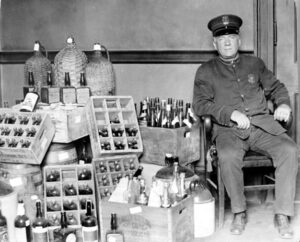
The investigating police arrested both Margaret Everdeane and Freda Horner as material witnesses. The police, determined to break the Gopher gang, pressured both Everdeane and Horner, who cracked under interrogation and they both implicated Madden in the murder; his luck had run out.
The authorities moved quickly and arrested Madden. This was the 57th time he had been arrested and apart from one traffic violation he had always walked away a free man.
This was because Owney and the Gophers always ensured that any potential witness knew it would be extremely harmful for their health and that of their loved ones if they testified against Owney Madden! But the police were determined to get a conviction this time.
The Gophers put pressure on Everdeane, and Horner and they eventually recanted their testimony, but the judge was having none of it and he maintained their earlier accusations were valid. Because of this Madden was found guilty and sentenced to 20 years in Sing Sing prison. His associates were also found guilty; McArdle received 30 years, and Biedler 18. (9)
Madden did nine years out of a twenty year sentence for murder. When released he found the criminal world transformed by the prohibition of alcohol in the Untied States.
Owney Madden was released on parole after nine years and quickly saw the landscape had changed dramatically.
His old gang the Gophers no longer existed, its members were either dead, in jail or had joined other crime gangs such as the White Hand gang, growing as a result of Prohibition and the new lucrative trade in illicit alcohol.
With the passing of the 18th Amendment in 1919 and the nationwide ban that went into effect in January 1920 on the sale or importation of “intoxicating liquor,” legitimate bars and breweries were now out of business.
There was still a substantial demand for alcohol, and no one was better equipped to supply this than the criminal underworld who had the networks needed to supply demand and the corrupt politicians and cops in their pocket to protect their growing enterprise. (10)
Looking for a foot on the new crime ladder, Madden joined the Dutch Schultz organisation as a lowly soldier. How- ever, because of his close friendship with ex-Gophers Larry Fay, Vincent ‘Mad Dog’ Coll and Legs Diamond he quickly rose through the ranks of the Shultz mob and in 1931 he left to set up his own gang.
During this period Madden employed a young man as his personal driver, a certain George Raft who would go on to be a major film star, famous for his uncanny portrayal of gangland figures.
Relationship with Mae West
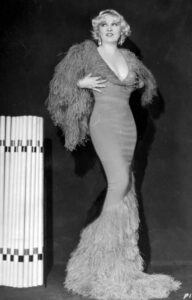
A girlfriend of Madden at this time was the film star Mae West who was soon drawn to the glamour and wealth of Madden who was fast rising through the ranks of the criminal underworld.
Madden met West at the Harding Hotel and quicky began a tempestuous relationship. West had the desire for fame and Madden had the wealth and connections to fund it.
In 1927 Madden financed a stage production written, produced and directed by West called Sex, which had prostitution as one of its central themes. Ten months into its run it was shut down by the acting Mayor of New York Joseph V. (“Holy Joe”) McKee who was standing in for New York’s mayor, Jimmy Walker, who had taken a holiday in mob-controlled Havana.
In February 1927 McKee with an eye on the next election and under pressure from the public decency lobby, ordered the police to raid risqué Broadway shows. West was the prime target: Sex, , had been seen by 325,000 theatre goers , including members of the police department and their wives, judges of the criminal courts, and seven members of the district attorney’s staff. (11)
To the delight of the tabloid press, its twenty actors were hauled off to a police station in Hell’s Kitchen. Mae West spent the night in the Jefferson Market Women’s Prison. Madden arranged for West and the cast to be bailed out and financed her defence at the later trial which garnered West massive free publicity and boosted her career. West was found guilty of public indecency and served 8 days in prison. Madden would help West financially throughout her life. (12)
West would describe Madden in her memoirs as:
“Sweet, but oh so vicious.” (13)
Madden the celebrity gangster
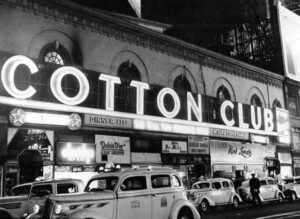
Madden’s criminal model was simple: he and his gang would hijack trucks ferrying bootleg booze from New York to the thirsty mid-west and then sell on the contents. While this was highly lucrative, it was also dangerous.
After hijacking liquor shipments belonging to Big Bill Dwyer, a war seemed likely. However, Dwyer, a very intelligent criminal, decided to talk rather than pull the trigger and suggested that Madden become his partner and become his muscle to stop any further hijacks.
Madden quickly introduced Dwyer to his friend George ‘Big Frenchy’ DeMange and suggested they funnel the enormous bootlegging profits into legitimate businesses such as nightclubs, the ideal way to launder the massive profits from their criminal activities.
They would go on to purchase and run the Cotton Club where patrons poured into Harlem from all over New York to listen to performers such as Duke Ellington, Louis Armstrong and Lena Horne.
Laundered his criminal wealth through the night club ‘The Cotton Club’, which he jointly owned with other organised crime figures.
The Cotton Club had originally been owned by the black prize-fighter Jack Johnson and was a mecca for New York nightlife in the 1930s. Madden and DeMange forced Johnson to sell up.
While the club continued to showcase the best in black entertainment, a ‘whites only’ patron policy was introduced. All non-whites, be they employees or entertainers, were forbidden to enter by the front door and no black patrons were allowed.
Madden also gave the owners of the Stork Club an offer they could not refuse and began to hold court at the most exclusive nightclub in New York. The Stork Club was the base for the gossip columnist, Walter Winchell, and was a popular venue for New York society’s elite.
Madden himself soon became a media personality and an iconic face of Prohibition-era crime and corruption. His wealth and reputation soon put him at logger- heads with the rising Italian crime syndicates headed by Lucky Luciano and Frank Costello who resented the power of the Irish mob and who wanted to replace them with their own organisations.
When his business partner Bill Dwyer was imprisoned in 1931, Madden knew Costello would soon make his move to take over Dwyer’s operations.
Ever the realist, Madden got out of bootlegging alive and used a payoff from Costello to enter the world of boxing becoming a promoter. Again, working with DeMange the pair managed some of the most famous boxers of the era, Rocky Marciano, Max Baer and Primo Carnera.
In February 1932, under pressure from Lucky Luciano, Madden was involved in the murder of his close friend and ex-Gopher, Vincent ‘Mad Dog’ Coll, who had a $50,000 bounty on his head. This was placed by Charles “Lucky” Luciano, who was incensed that Mad Dog had been hired to kill him by mob boss Salvatore Maranzano. Luciano decided both Maranzano and Coll would have to go.
Madden set up his old friend, promising a peace summit and Vincent was assassinated by two of Luciano’s men at a drug store on 8th Avenue. (14)
Fixing the world heavyweight boxing championship
Madden was now distancing himself from the New York crime scene and concentrating on his boxing pro- motions business. He took a particular interest in Primo Carnera.
Carnera was a giant of a man but not a particularly good boxer and an unlikely world title contender. Madden ensured, through fight-rigging, that Primo Carnera earned an undeserved shot at the world heavy- weight title.
In 1933 he fought the then-champion Jack Sharkey, knocking him out in six rounds. The fight was so clearly rigged that calls for an inquiry soon became thunderous.
The wily Madden thought of a solution, he dropped Carnera and arranged for another of his fighters, the famous German heavyweight Max Baer, to challenge him. Baer did not need a fight fixed and won easily in their bout on June 14, 1934. (15)
Leaving New York
Madden was now under severe pressure from the five Mafia families who by that time largely controlled organised crime in New York. Their control of the police led to Madden being imprisoned briefly for a parole violation. Madden thereafter decided it was time to leave New York.
Looking for a new life he had begun visiting Hot Springs, Arkansas, which under the corrupt mayor, Leo P McLaughlin, had become a safe haven for bootlegging, prostitution and gambling.
Madden was now in his 40s and suffering chronic ill health due to his numerous gunshot wounds; he needed a rest.
Despite its criminal links, Hot Springs was also known for its health-reviving waters and was just the place for Madden to recuperate.
Madden was ultimately forced out of New York by the Italian mafia and set himself up as a hotelier in Hot Springs Arkansas
Madden left for Hot Springs in 1934 and soon the notorious womaniser soon began romancing a local gift shop clerk, Agnes Demby. They would marry on November 26, 1935, and remain married for the rest of Owney’s life. Agnes was no fool and knew all about his past and future plans.
It has been speculated that ill health was not the only reason that led Madden to move to Hot Springs. It was unusual for a mobster to give up his operations peacefully. Given his relationship with Frank Costello and Lucky Luciano, it is possible they may have even brokered a peace deal and exit package. Lucky Luciano also had close links with Hot Springs’ Mayor McLaughlin, and Municipal Judge, Vern Ledgerwood. (16)
Could Luciano have encouraged Madden to move to Hot Springs to take advantage of their corrupt nature? It is certainly plausible, as Madden eventually helped both McLaughlin and Ledgerwood run their own criminal syndicate.
While both denied any involvement by Madden, it was common knowledge that Owney had supplied them with the wire service they used to bring racing results from all over the country to the Hot Springs bookmakers.
Hotelier to the mob
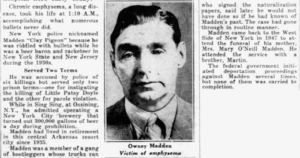
In 1940, feeling rejuvenated, Madden officially resurfaced and opened a hotel, spa and casino and kept his hand in the local underworld, but managed to stay out of trouble and the headlines. Madden also owned a controlling interest in the Southern Club, a luxurious and lucrative hotel and gam- bling establishment on Hot Springs Central Avenue. Hardly lying low.
His growing empire included interests in numerous other gambling and prostitution establishments. Madden kept out of the papers, but the Southern Club became the recreational hideaway of the who’s who of organised crime. Frank Costello, Meyer Lansky and Lucky Luciano all visited Madden regularly and in the open, enjoying holidays with their families. The Southern Club was also used for organised crime summits and as a venue for dispute resolution. (17)
Perhaps rest and recuperation wasn’t the reason Madden moved to Hot Springs after all. The English-born Madden finally became an American citizen in 1943 but would not give up his British passport until 1950. Despite this Madden remained a proud Irishman.
When in the 1960s, the US authorities began to crack down on organised crime, Irish Americans were to be found prominently on both sides of the law.
In post-war America, the authorities began to look more closely at organised crime. The corrupt Hot Springs McLaughlin political machine was voted out of power in 1946. However, through bribery and police corruption Madden’s rackets still flourished and the mob elite continued to ‘holiday’ in Hot Springs.
Throughout the 50s and early 60s, Madden was a familiar figure in Hot Springs, becoming patron of numerous charities and easily recognisable in his trade- mark Irish cloth cap and scarf. No police action was taken against him, but the tide was turning.
With the election of John F Kennedy as President and the appointment of his brother Robert as Attorney General, state action on organised crime cranked up.
Late in 1961 a federal investigation concluded that Hot Springs Arkansas was “the site of the largest illegal gambling operation in the United States”.
Despite his denials of involvement, Owney Madden was summoned to appear before the US Senate committee on organised crime under Arkansas senator, John McClellan.
The senate investigation committees, which included Irish American politicians from both political parties, highlights that the Irish middle class had entered legitimate America. Perhaps the zeal of some, such as Robert Kennedy was perhaps a reaction to a feeling of embarrassment that part of the Irish diaspora was still heavily involved in criminal activities.
In a session of robust questioning, true to his Gopher roots, Owney Madden told the authorities nothing of consequence or substance, frequently pleading the Fifth Amendment. The exasperated authorities could not pin anything on Madden, and he avoided any charges.
Three years later in 1964, the authorities took its first major steps in shutting down illegal operations in Hot Springs, closing numerous gambling joints and brothels.
This was of little consequence to Owney Madden, who died on April 24, 1965, following a bout of emphysema. He died in his own home, one of the few major gangsters of his time to end his life quietly in bed, unlike his many friends and enemies. He was survived by his loyal wife Agnes. They had no children.
A peaceful end for Owney ‘The Killer’ Madden who ended up entertaining the mob on their holidays.
You can read all about Owney in John Joe McGinley’s book Irish Wise Guys.
Sources
- The Irish in Leeds Brendan McGowan 2004
- “The Duke of the West Side: Owney “The Killer” Madden”. com
- Craig Thompson and Allen Raymond, Gang Rule in New York: Dial Press, 1940
- nationalcrimesyndicate.com
- “The Duke of the West Side: Owney “The Killer” Madden”. com
- “The Duke of the West Side: Owney “The Killer” Madden”. com
- “The Duke of the West Side: Owney “The Killer” Madden”. com
- Craig Thompson and Allen Raymond, Gang Rule in New York: Dial Press, 1940
- Craig Thompson and Allen Raymond, Gang Rule in New York: Dial Press, 1940
- history.com/news/prohibition-organized-crime-al-capone
- com March 2021
- com March 2021
- George Eells; Musgrove, Stanley (1982). Mae West: A Biography
- The Five Families. MacMillan. May 13, 2014.
- “The Duke of the West Side: Owney “The Killer” Madden”. com
- The Five Families. MacMillan. May 13, 2014.
- The Five Families. MacMillan. May 13, 2014.